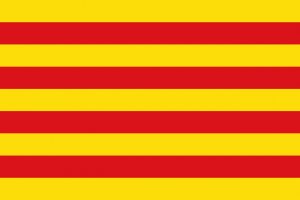Language/Catalan/Grammar/Negation
Hi Catalan learners! 😊
In this lesson, you are going to learn about the negation in Catalan. Negation is a fundamental component of grammar in any language. By mastering how to negate in Catalan, you will create more complex and accurate communication. Negation allows us to say what something is not or the opposite of something. In other words, it is the grammatical term for using words such as "no," "never," "nothing," and "nobody."
Take some time to dive into these other pages after completing this lesson: How to say "there is" in Catalan, Indefinite Articles in Catalan, How to say there is in Catalan & Reflexive verbs.
Basic Negation[edit | edit source]
The most common way to negate in Catalan is by using the word "no." This word goes before the verb in the sentence. It is quite similar to how we use "not" in the English language.
For example:
| Catalan | Pronunciation | English |
|---|---|---|
| No parlo català. | /nu ˈpaɾ.lo kə.təladʒa/ | I do not speak Catalan. |
In this example, you can see that the word "no" goes before the verb "parlo," which means "speak." Another example would be:
| Catalan | Pronunciation | English |
|---|---|---|
| Ell no té cotxe. | /el no tə ˈkɔtʃə/ | He does not have a car. |
Here, "no" appears before the verb "té," meaning "have."
Negation with Pronouns[edit | edit source]
When we use pronouns in a negative sentence, we place the negative particle, "no," before the pronoun.
For example:
| Catalan | Pronunciation | English |
|---|---|---|
| No t'agrada la paella. | /nu taˈɣɾaðə ɫə paˈeʎə/ | You do not like paella. |
In this example, "no" is placed before the pronoun "t'agrada," meaning "you like." Another example would be:
| Catalan | Pronunciation | English |
|---|---|---|
| No ens ho van dir. | /nu əns o van ˈdiɾ/ | They did not tell us. |
Here, "no" goes before the pronoun "ens ho," meaning "us" in the sentence.
Double Negation[edit | edit source]
In Catalan, double negation is used to give more emphasis to the negation. It is quite common to use this in informal conversations, especially when you need to express your disagreement.
For example:
| Catalan | Pronunciation | English |
|---|---|---|
| No vull anar a cap lloc. | /nu buʎ əˈnaɾ a kap lɔk/ | I don't want to go anywhere. |
| No vull anar a cap lloc pas. | /nu buʎ əˈnaɾ a kap lɔk pas/ | I don't want to go anywhere, no way. |
Here, you can see that "pas" is used to intensify the negation in the second sentence for more emphasis.
Negation with Adverbs[edit | edit source]
Another way to make negative sentences in Catalan is by using adverbs. Adverbs are words that describe the manner, circumstance or degree of an action, quality or event in a sentence.
For example:
| Catalan | Pronunciation | English |
|---|---|---|
| Mai he deixat de estudiar. | /maj ə dəˈʒeʃat də əstudiˈa/ | I have never stopped studying. |
| Res és més important que la salut. | /rɛs ɛs mes im.porˈtant kə la saˈlut/ | Nothing is more important than health. |
In the first example, "mai" means "never." It is useful to use it when you need to express that something has never happened or you never do something. In the second example, "res" means "nothing." Here, the sentence implies that there is nothing more important than health.
Dialogue[edit | edit source]
- Person 1: Has anat mai a la platja? (/as əˈnat maj a la ˈpɫadʒə/ - Have you ever been to the beach?)
- Person 2: No, no m'agrada. (/nu, nu məˈɣɾaðə/ - No, I don't like it.)
- Person 1: No t'agrada el sol llavors? (/no taˈɣɾaðə ɫə suɫ ʎəˈβɔɾs/ - You don't like the sun then?)
- Person 2: Sí, m'agrada el sol, però no la sorra. (/si, məˈɣɾaðə ɛɫ suɫ, ˈpeɾo nu la ˈsoʎə/ - Yes, I like the sun, but not the sand.)
Conclusion[edit | edit source]
Negation is a fundamental aspect of grammar in the Catalan language. By mastering how it works, you can communicate more accurately and effectively. Remember that the word "no" is placed before the verb in a sentence, and "res" or "mai" can be used for specific instances.
To improve your Catalan Grammar, you can also use the Polyglot Club website. Find native speakers and ask them any questions!
Sources[edit | edit source]
- Catalan Negation
- Double Negation in Catalan and Spanish. Interaction Between ...
- Early Negation in Catalan and Spanish*
Now that you've completed this lesson, don't stop learning! Check out these related topics: Ordinal Numbers in Catalan, Introduction to adjectives and adverbs in Catalan Grammar, How to use "can" in Catalan & Future Tense.

